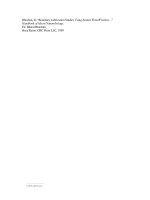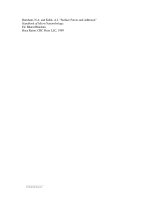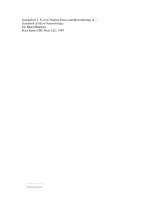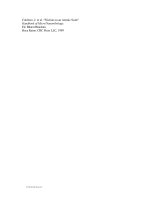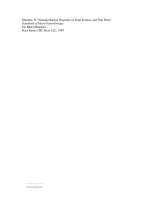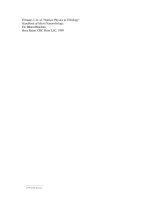- Trang chủ >>
- Khoa Học Tự Nhiên >>
- Vật lý
biomechanics at micro- and nanoscale levels, v.iii, 2007, p.182
Bạn đang xem bản rút gọn của tài liệu. Xem và tải ngay bản đầy đủ của tài liệu tại đây (16.22 MB, 182 trang )
BIOMECHANICS
AT
MICRO-
AND NANOSCALE
LEVELS
VOLUMEII
Biomechanics at Micro- and Nanoscale Levels
Editor-in-Charge: Hiroshi Wada
(Tohoku University, Sendai, Japan)
Published
Vol. I: Biomechanics at Micro- and Nanoscale Levels
Edited by Hiroshi Wada
ISBN 981-256-098-X
Vol. II: Biomechanics at Micro- and Nanoscale Levels
Edited by Hiroshi Wada
ISBN 981-256-746-1
BIOMECHANICS AT MICRO-
AND
NANOSCALE
LEVELS
Selected Papers from the Proceedings of the Fifth World Congress
of
Biomechanics, Thread
3:
Biomechanics at Micro- and Nanoscale Levels
VOLUME
I11
editor
H
iroshi
Wada
Tohoku
University, Sendai, Japan
vp
World
Scientific
NEW JERSEY
-
LONDON
*
SINGAPORE
*
BElJlNG SHANGHAI
*
HONG KONG
*
TAIPEI
*
CHENNAI
British Library Cataloguing-in-Publication Data
A catalogue record for this book is available from the British Library.
For photocopying of material in this volume, please pay a copying fee through the Copyright
Clearance Center, Inc., 222 Rosewood Drive, Danvers, MA 01923, USA. In this case permission to
photocopy is not required from the publisher.
ISBN-13 978-981-270-814-4
ISBN-10 981-270-814-6
All rights reserved. This book, or parts thereof, may not be reproduced in any form or by any means,
electronic or mechanical, including photocopying, recording or any information storage and retrieval
system now known or to be invented, without written permission from the Publisher.
Copyright © 2007 by World Scientific Publishing Co. Pte. Ltd.
Published by
World Scientific Publishing Co. Pte. Ltd.
5 Toh Tuck Link, Singapore 596224
USA office: 27 Warren Street, Suite 401-402, Hackensack, NJ 07601
UK office: 57 Shelton Street, Covent Garden, London WC2H 9HE
Printed in Singapore.
BIOMECHANICS AT MICRO- AND NANOSCALE LEVELS
Volume III
v
PREFACE
A project on “Biomechanics at Micro- and Nanoscale Levels,” the title of this
book, was approved by the Ministry of Education, Culture, Sports, Science and
Technology of Japan in 2003, and this four-year-project is now being carried out by
fourteen prominent Japanese researchers. The project consists of four fields of
research, namely, Cell Mechanics, Cell Response to Mechanical Stimulation, Tissue
Engineering, and Computational Biomechanics.
Our project can be summarized as follows. The essential diversity of
phenomena in living organisms is controlled not by genes but rather by the
interaction between the micro- or nanoscale structures in cells and the genetic code,
the dynamic interaction between them being especially important. Therefore, if the
relationship between the dynamic environment of cells and tissues and their function
can be elucidated, it is highly possible to find a method by which the structure and
function of such cells and tissues can be regulated. The first goal of this research is
to understand dynamic phenomena at cellular and biopolymer-organelle levels on
the basis of mechanics. An attempt will then be made to apply this understanding to
the development of procedures for designing and producing artificial materials and
technology for producing or regenerating the structure and function of living
organisms.
At the 5th World Congress of Biomechanics held in Munich, Germany from
29th July to 4th August, 2006, we organized the following sessions:
Thread 3: Biomechanics at micro- and nanoscale levels
1. Cell mechanics
2. Molecular biomechanics
3. Mechanobiology at micro- and nanoscale levels
4. Computational biomechanics
We are planning to publish a series of books related to this project, the present
volume being proceedings covering topics related to the sessions we organized. I
would like to express my sincere gratitude to Professor Dieter Liepsch, the President
of the 5th World Congress of Biomechanics, who granted us permission to publish
these proceedings, as well as to the ten researchers who contributed to these
proceedings.
Hiroshi Wada, PhD,
Project Leader,
Tohoku University,
Sendai,
December, 2006
vii
5th World Congress of Biomechanics
FOREWORD
Munich, December, 2006
This volume represents the finest research of some of the best investigators in the
world and I am very honored that these important and ground-breaking papers were
presented at the 5th World Congress of Biomechanics in Munich, in 2006.
Between July 31st and August 4th, 2006, nearly 2600 scientists and 900
students from 64 countries, representing every continent, came to Munich, Germany
to listen, learn and share their latest work in all fields of biomechanics. It quickly
became obvious the newest trends lay in the fields of tissue and cellular
biomechanics. It was also clear that the field was so rich and multi-faceted that it
warranted an orthogonal ‘thread’ which would cut across all the various fields of
research, showing the connections, interrelations and interdependencies. Under the
guidance of Prof. Dr. Hiroshi Wada, Thread 3 “Biomechanics at micro- and
nanoscale levels” incorporated cell mechanics, molecular biomechanics,
mechanobiology at micro- and nano-scale levels and computational biomechanics.
When Prof. Hiroshi Wada first raised the possibility of incorporating micro-
and nanoscale biomechanics into the 5th World Congress of Biomechanics, I knew
that without this contribution, we could not hope to present to the international
community the full scope and richness of this increasingly vital field of research. It
was my pleasure and honor to be able to present to the international scientific world
and to our students, the work of the scientists represented in this volume. This
volume is the work of dedicated scientists who have earned the respect and esteem
of their peers around the world and who have opened the door to new vistas of
research for a new generation of students and young investigators. I am grateful to
have played a small part in bringing this work to the international scientific
community.
With best regards
Dieter Liepsch
Congress President
This page intentionally left blankThis page intentionally left blank
ix
CONTENTS
PREFACE v
FOREWORD vii
I. CELL MECHANICS 1
The effect of streptomycin and gentamicin on outer hair cell motility 3
B. Currall, X. Wang and D. Z. Z. He
Mechanotransduction in bone cell networks 13
X. E. Guo, E. Takai, X. Jiang, Q. Xu,
G. M. Whitesides, J. T. Yardley, C. T. Hung and K. D. Costa
Intracellular measurements of strain transfer with texture correlation 36
C. L. Gilchrist, F. Guilak and L. A. Setton
II. CELL RESPONSE TO MECHANICAL STIMULATION 49
Identifying the mechanisms of flow-enhanced cell adhesion 51
via dimensional analysis
C. Zhu, V. I. Zarnitsyna, T. Yago and R. P. McEver
A sliding-rebinding mechanism for catch bonds 66
J. Lou, C. Zhu, T. Yago and R. P. McEver
Role of external mechanical forces in cell signal transduction 80
S. R. K. Vedula, C. T. Lim, T. S. Lim, G. Rajagopal,
W. Hunziker, B. Lane and M. Sokabe
III. TISSUE ENGINEERING 105
Evaluation of material property of tissue-engineered cartilage 107
by magnetic resonance imaging and spectroscopy
S. Miyata, K. Homma, T. Numano, K. Furukawa,
T. Ushida and T. Tateishi
Contents x
Scaffolding technology for cartilage and osteochondral 118
tissue engineering
G. Chen, N. Kawazoe, T. Tateishi and T. Ushida
IV. COMPUTATIONAL BIOMECHANICS 131
MRI measurements and CFD analysis of hemodynamics 133
in the aorta and the left ventricle
M. Nakamura, S. Wada, S. Yokosawa and T. Yamaguchi
A fluid-solid interactions study of the pulse wave velocity 146
in uniform arteries
T. Fukui, Y. Imai, K. Tsubota, T. Ishikawa, S. Wada,
T. Yamaguchi and K. H. Parker
Rule-based simulation of arterial wall thickening induced 157
by low wall shear stress
S. Wada, M. Nakamura and T. Karino
SUBJECT INDEX 167
This page intentionally left blankThis page intentionally left blank
I. CELL MECHANICS
This page intentionally left blankThis page intentionally left blank
3
THE EFFECT OF STREPTOMYCIN AND GENTAMICIN ON
OUTER HAIR CELL MOTILITY
B. CURRALL, X. WANG AND D. Z. Z. HE
Department of Biomedical Sciences, Creighton University School of Medicine
Omaha, Nebraska, 68178, USA
E-mail:
The cochlear outer hair cell (OHC), which plays a crucial role in mammalian hearing through
its unique voltage-dependent length change, has been established as a primary target of the
ototoxic activity of aminoglycoside antibiotics. Although the ototoxicity eventually leads to
hair cell loss, these polycationic drugs are also known to block a wide variety of ion channels
such as mechanotransducer channels, purinergic ionotropic channels and nicotinic ACh
receptors in acute preparations. The OHC motor protein prestin is a voltage-sensitive
transmembrane protein which contains several negatively charged residues on both intra- and
extracellular surface. The acidic sites suggest that they may be susceptible to polycationic-
charged aminoglycoside binding, which could result in a disruption of somatic motility. We
attempted to examine whether aminoglycosides such as streptomycin and gentamicin could
affect the mechanical response of OHCs. Solitary OHCs isolated from adult gerbils were
used for the experiments. Somatic motility and nonlinear capacitance were measured under
the whole-cell voltage-clamp mode. Streptomycin and gentamicin were applied
extracellularly or intracellularly. Results show that streptomycin and gentamicin, for the
concentration range between 100 µM and 1 mM, did not affect somatic motility or nonlinear
capacitance. The result suggests that although streptomycin and gentamicin can block
mechanotransduction channels as well as ACh receptors in hair cells, they have no immediate
effect on OHC somatic motility.
1 Introduction
Aminoglycosides are low cost, high efficacy antibiotics, however, their use is
limited by their nephrotoxic and ototoxic activity. Several toxic mechanisms have
been associated with aminoglycosides. In genetically susceptible individuals, a
mitchodonrial mutation for an rRNA may be vulnerable to aminoglycoside
interference [1]. It has also been shown that N-methyl-D-apartate (NMDA)
receptor, found in afferent neurons, may be affected by aminoglycosides, resulting
in excitotoxicity followed by hair cell death [2]. Also, upon entry into the cell,
whether via vesicle-mediated process [3] or the mechanoelectical transuction
channel [4], reactive oxygen species, free radicals and nitiric oxide form, resulting
in multiple signaling pathways that may lead to subsequent cell death [5-8]. While
nephro- and ototoxicity seem to depend on intracellular accumulation of these
antibiotics [9-10], numerous studies have demonstrated the ability of these
polycationic drugs to acutely depress synaptic transmission at the neuromuscular
junction, presumably by blocking presynaptic voltage-gated Ca
2+
channels [11-12].
These polycationic drugs also block a wide variety of ion channels such as
B. Currall, X. Wang & D. Z. Z. He 4
mechanosensitive ion channels [13-14], purinergic ionotropic channels [15] and
nicotinic ACh receptors [16-17].
In the cochlea, the ototoxic activity of aminoglycosides is characterized by a
loss of outer hair cells (OHCs). The OHC is one of two receptor cells in the organ
of Corti, and plays a critical role in mammalian hearing. OHCs are able to rapidly
change their length [18-19] and stiffness [20] at acoustic frequencies when their
transmembrane potential is altered. This fast somatic motility is believed to be the
substrate of cochlear amplification [18, 21]. OHC electromotility is driven by
voltage-sensitive molecules (or assemblies of molecules) able to change area when
the membrane potential is altered. Both the motor and its sensor are located in the
plasma membrane [22-24]. Recently, the gene prestin that codes the motor protein
was identified [25]. The targeted deletion of prestin in mice results in the loss of
electromotility in vitro, and a 40-60 dB loss in cochlear sensitivity in vivo [21]. The
protein prestin is a voltage-sensitive transmembrane protein which contains several
negatively charged residues on both intra- and extracellular surface [26]. The acidic
sites suggest that they may be susceptible to aminoglycoside binding [27], which
could result in a disruption of somatic motility. Therefore, the purpose of this
study was to determine whether the aminoglycosides such as streptomycin and
gentamicin could affect the mechanical response of OHCs.
2 Materials and Methods
2.1 Preparation of isolated OHCs
Gerbils (Meriones unguiculatus) ranging in age between 4 and 8 weeks were
anesthetized with an intraperitoneal injection of a lethal dose of sodium
pentobarbital (150 mg/kg) and then decapitated. Cochleae were dissected out and
kept in cold culture medium (Leibovitz’s L-15). L-15 (Gibco) was supplemented
with 10 mM HEPES (Sigma) and adjusted to 300 mOsm and pH 7.4. After the
cochlear wall was removed, the BM-organ of Corti complex was unwrapped from
the modiolus from the base to the apex. The organ of Corti was dissected out from
the apical turn of the cochlea. The tissue was then transferred to the enzymatic
digestion medium [L-15 supplemented with 1 mg/ml collagenase type IV (Sigma)].
After 10 minutes incubation at room temperature (22±2°C), the tissue was
transferred to the experimental bath containing fresh L-15 medium. To obtain
solitary OHCs, gentle trituration of the tissue with a small pipette was applied. A
cell was selected for experimentation only if its diameter was approximately
constant throughout its length and if it showed no signs of damage, such as
swelling, blebbing, and dislocation of the nucleus. Cells were rejected if visible
signs of damage and appearance changes occurred during the experiment.
2.2 Whole-cell voltage-clamp recording
Isolated OHCs were placed in the experimental chamber containing extracellular
The Effect of Streptomycin and Gentamicin on Outer Hair Cell Motility
5
fluid (pH 7.2, 320 mOsm, in mMol: NaCl
2
120, TEA-Cl
20, CoCl
2
2.0, MgCl
2
2.0,
CaCl
2
1.5, HEPES
2
10, Glucose
5.0) on the stage of an inverted microscope
(Olympus IX–71). The patch electrodes were pulled from 1.5 mm glass capillaries
(A-M System) using a Flaming/Brown Micropipette Puller (Sutter Instrument
Company, Model P-97). The electrodes were back-filled with solution containing
(in mM) CsCl 140; CaCl
2
; 0.1; MgCl
2
3.5; Na
2
ATP; 2.5; EGTA-KOH 5; HEPES-
KOH 10. The solution was adjusted to pH 7.4 with CsOH (Sigma) and osmolarity
adjusted to 300 mOsm with glucose. These solutions enabled to block K
+
and Ca
2+
conductances to isolate gating currents associated with somatic motility. The
pipettes had initial bath resistances of 2-4 MΩ. The access resistance, that is, the
actual electrode resistance obtained upon establishment of the whole-cell
configuration, typically ranged from 6 to 12 MΩ. Series resistance was corrected
off-line after data collection. Aminoglycosides were applied either extracellularly,
with aminoglycosides placed in separate perfusion pipette, or intracellularly, with
aminoglycosides placed in the patch pipette. Extracellular perfusion pipettes were
placed within 60 µm of cell, after achieving whole-cell configuration, and perfusion
started by opening gravity fed T-tubule switch. Streptomycin sulfate, and
gentamicin sulfate were diluted to concentration specified in figures captions.
2.3 Somatic motility measurements
Somatic motility was measured and calibrated by photodiode-based measurement
systems [28] mounted on the Olympus inverted microscope. The OHC was imaged
using a 40x objective and magnified by an additional 20x relay lens. The magnified
image of the edge of the cell was then split into two paths: one path projected onto
the photodiode (Hamamatsu) through a slit and another projected onto a CCD
camera so that the edge of the cell could be viewed at all times on a television
monitor. During measurements, the magnified image of the edge of the cell was
positioned near the edge of the slit. The slit was rotated, based on the orientation of
the cell. The photodiode system had a cutoff (3-dB) frequency of 1,200 Hz. The
signal was then amplified by a 60-dB fixed-gain dc-coupled amplifier. The
amplified signal was then low-pass filtered (400 or 1,100 Hz) before being
delivered to one of the A/D inputs of a Digidata (1322A, Axon Instruments)
acquisition board in a Window-based PC. The measurement system was capable of
measuring motions down to ~5 nm with 100 averages. Calibration was performed
by moving the slit a known distance (1 µm).
2.4 Nonlinear capacitance measurements
The AC technique was used to obtain motility-related gating charge movement and
the corresponding NLC. This technique has been described in details elsewhere
[29]. In brief, it utilized a continuous high-resolution (2.56 ms sampling) two-sine
voltage stimulus protocol (10 mV peak at both 390.6 and 781.2 Hz), with
subsequent fast Fourier transform-based admittance analysis. These high frequency
sinusoids were superimposed on voltage ramp stimuli. The NLC can be described
B. Currall, X. Wang & D. Z. Z. He 6
as the first derivative of a two-state Boltzmann function relating nonlinear charge
movement to voltage [30-31]. The capacitance function is described as:
lin
mm
m
C
VVVV
Q
C +
−−+−
=
2
2/12/1
max
)])(exp[1)]((exp[
αα
α
where, Q
max
is maximum charge transfer, V
1/2
is the voltage at which the maximum
charge is equally distributed across the membrane, C
lin
is linear capacitance, and
α
= ze/kT is the slope factor of the voltage dependence of charge transfer where k is
Boltzmann’s constant, T is absolute temperature, z is valence, and e is electron
charge. Capacitive currents were filtered at 2 kHz and digitized at 10 kHz using
jClamp software (SciSoft Company), running on an IBM-compatible computer and
a 16-bit A/D converter (Digidata 1322A, Axon Instruments).
3 Results
3.1 Extracellular application of streptomycin and gentamicin
OHC motility was measured from isolated cells before and after streptomycin and
gentamicin were applied to the extracellular solution through a puffer pipette
positioned 60 µm away from the cells. The cells were held at -70 mV and voltage
steps varying from -120 mV to 60 mV were used to evoke motility. Fig. 1 shows
examples of two OHCs before and 2-minutes after 100 µM streptomycin and
gentamicin were applied. The motile response was asymmetric, with contraction
being larger than the elongation. The response was also nonlinear, with saturation
at both directions. We measured a total of 10 cells
(5 cells each) for streptomycin and gentamicin at
the concentration of 100 µM. Streptomycin and
gentamicin did not change the magnitude nor the
asymmetry of the response as shown in Fig. 1.
Figure 1. Voltage to length change function measured before (in
black) and 2-minutes after 100 µM streptomycin and gentamicin
were applied (in red). The cells were held at -70 mV under
whole-cell voltage-clamp mode. Voltage steps varying from -120
mV to 60 mV were applied to evoke motility. Motility
magnitude was measured from the steady-state responses.
Voltage error due to series resistance was compensated. Note
that neither the magnitude nor the response characteristics were
changed after the treatment.
Associated with the OHC electromotility is an electrical signature, a voltage-
dependent capacitance or, correspondingly, a gating charge movement [30-31],
similar to the gating currents of voltage-gated ion channels [32]. The gating
currents are thought to arise from a redistribution of charged voltage sensors across
The Effect of Streptomycin and Gentamicin on Outer Hair Cell Motility
7
the membrane. This charge movement imparts a bell-shaped voltage dependence
to
the membrane capacitance [30-31]. Measures of nonlinear capacitance (NLC) have
been used to assay OHC’s motor function [25, 31]. We measured NLC before and
after streptomycin and gentamicin were applied to the cells. Fig. 2 shows some
representative responses from two OHCs. NLCs were measured before and 2-
minutes after 100 µM streptomycin and gentamicin were applied through a
perfusion pipette positioned 60 µm away from the cells. As shown, the capacitance
function was bell-shaped with respect to
stimulating voltage. The NLC exhibited a peak
around -50 mV for both cells showed in the
example. As shown, the magnitude of the peak
capacitance did not change significantly after the
treatment. We compared the maximum charge
transfer (Q
max
), C
non-lin
, and slope factor (α). None
of them changed significantly after the treatment.
Figure 2. Capacitance measured from two OHCs before (in
balck) and 2-miuntes (in red) after 100 µM streptomycin and
gentamicin were applied to the extracellular solution. Note that
neither the magnitude of the peak capacitance nor the V
1/2
changed after perfusion.
The changes in peak capacitance (Cm
pk
) have been used to examine the
effects of certain agents on OHC motility [33]. We also monitored Cm
pk
during
application of streptomycin and gentamicin to further determine their influence on
motility. For positive control, we monitored the change in Cm
pk
after salicylate was
applied extracellularly. Salicylate is known to significantly reduce OHC somatic
motility and NLC [26, 33]. Cm
pk
was monitored using the software in the jClamp
(version 12.1) package over the course of 2 to 4 minutes after aminoglycosides or
salicylate was applied. Fig. 3 shows an example of such recordings. As shown,
5 mM salicylate caused significantly
reduction in Cm
pk
. However, neither
streptomycin nor gentamicin had any
affect on Cm
pk
.
Figure 3.
Peak capacitance (Cm
pk
) monitored after
streptomycin and gentamicin was applied to the
extracellular solution. For positive control, 5 mM
salicylate was applied. The cells were held at -40 mV
under whole-cell voltage-clamp condition. Cm
pk
was
measured using the software in the jClamp package.
Bar indicates the duration that streptomycin was
perfused. Note that Cm
pk
was significantly reduced
after 5 mM salicylate was applied. However,
neither
streptomycin nor gentamicin had any affect on Cm
pk
.
While it has been demonstrated that 100 µM streptomycin or gentamicin is
enough to block mechanoelectrical transducer current as well as ACh receptor in
B. Currall, X. Wang & D. Z. Z. He 8
hair cells, we inquired whether it requires even higher concentration to be effective
to affect OHC somatic motility. Peak capacitance was monitored using the software
in the jClamp package over the course of
experiments when streptomycin with
concentration of 0.1, 0.2, 0.5 and 1 mM was
applied. Fig. 4 illustrates the peak
capacitance measured from OHCs in
response to different concentrations of
streptomycin applied to the extracellular
solution. As shown, the peak capacitance did
not change for all the concentrations applied.
Figure 4. Peak capacitance monitored with different
concentration of streptomycin applied to the
extracellular solution. Peak capacitance was measured
using the software in the jClamp package. Bar indicates
the duration when streptomycin was perfused.
3.2 Intracellular application of streptomycin
Aminoglycosides can enter hair cells through the open mechanotransducer channels
[4]. So we inquired whether aminoglycosides disturbed somatic motility when they
were applied intracellularly. We examined such possibility by monitoring somatic
motility immediately after rupturing the cells and throughout the entire course when
the streptomycin (together with normal intracellular solution) in the patch electrode
diffused to the cytosol of the cells. Fig. 5 illustrates an example of such recordings
from a gerbil apical turn OHC. The cell was held at -40 mV and a 5 Hz sinusoidal
voltage command with peak-to-peak amplitude of 30 mV was continuously applied
to the cell to evoke motility. Motility was measured using a photodiode-based
displacement system. Since the streptomycin in the patch electrode diffused to the
cytosol took time (normally it would take 20 to 30 second to equilibrate), the
motility measured immediately after rupturing was used as control [34]. Motility
Figure 5. Motility measured after
streptomycin was applied intracellularly
through the patch electrode. Arrow
indicates the moment when the cell’s
membrane was ruptured and streptomycin
started to diffuse to the cytosol of the cell.
The cell was held at -40 mV and 5 Hz
sinusoidal voltage stimulus with peak-to-
peak magnitude of 30 mV was continuously
delivered to the cell to evoke motility.
Three representative responses in the top
panels were acquired at 10 seconds before
and after the cell was ruptured, and at 30
and 200 seconds after the cell was ruptured. Steady-state responses (peak-to-peak) at different moments
during perfusion were measured and plotted in the bottom panel.
The Effect of Streptomycin and Gentamicin on Outer Hair Cell Motility
9
was observable immediately after the cell was ruptured. We measured the
magnitude of motility at different times during perfusion and the magnitude of
motility is plotted in the bottom panel of Fig. 5. As shown, the magnitude of
motility remained basically the same throughout the course of equilibrium. This
suggests that motility is not affected by intracellular application of streptomycin.
4 Discussion
Aminoglycosides are large, lipid insoluble, polycationic molecules that are known
to block a variety of ion channels including large-conductance Ca
2+
-activated K
+
channels [35], Ca
2+
channels [36] and ryanodine receptors [37]. In hair cells,
aminoglycosides have been reported to block transducer channels [13-14], ATP
receptors [15], nicotinic acetylcholine receptors [16] and large-conductance Ca
2+
-
activated K
+
channels [16]. Aminoglycosides have a strong propensity to associate
with negatively charged lipid bilayers [38] and to compete at Ca
2+
binding sites on
the plasma membrane of OHCs [39].
Contrary to our expectations that streptomycin or gentamicin would be able to
screen a significant proportion of fixed negative charges in prestin, we saw no
reduction in either NLC or somatic motility by gentamicin or streptomycin. Though
100 µM of either streptomycin or gentamicin has been found potent enough to block
mechanotransducer channels and ACh receptors (cite), we found no influence on
somatic motility despite concentrations as high as 1 mM. We monitored the change
in peak capacitance for over 4 minutes, long enough to see the effect if any. It is
possible that such screening effect on negative charges do not affect the function of
prestin.
Aminoglycosides enter hair cells via vesicle-mediated process [3] or the
mechanoelectrical transuction channel [4]. Since the hair bundle is usually
damaged in isolated OHCs, it is possible that the concentration of streptomycin or
gentamicin inside the cell was too low to produce any effect. However, since we
also did not see any effect when streptomycin was applied intracellularly, such
possibility could be rule out.
Despite the high concentrations used, this study does not eliminate the
possibility that aminoglycosides may have some effect on somatic motility in the
long term. Hearing loss as a result of aminoglycoside dosage is delayed and may
require an accumulation of aminoglycosides over a period of time [3]. A recent
paper also suggests that the MET may act as a one-way valve for aminoglycosides,
resulting in high concentration of cytosolic aminoglycosides [4]. Athough it is
possible that higher concentrations of aminoglycosides may accumulate inside the
cells which may disturb motility through secondary processes, therapeutic levels of
aminoglycosides are expected to be well below the concentrations used in this
study. This study suggests that aminoglycosides do not have any immediate or
direct effect on OHC somatic motility.
B. Currall, X. Wang & D. Z. Z. He 10
Acknowledgment
This work was supported by NIH grant R01 DC004696 to D.H.
References
1. Guan, M., Fischel-Ghodsian, N., Attardi, G., 2000. A biochemical basis for the
inherited susceptibility to aminoglycoside ototoxicity. Human Mol. Genetics 9,
1787-1793.
2. Duan, M., Agerman, K., Emfors, P., Canlon, B., 2000. Complementary roles of
neurotrophin 3 and a N-methyl-D-aspartate antagonist in the protection of noise
and aminoglycoside-induced ototoxicity. Proc. Natl. Acad. Sci. USA 97, 7597-
7602.
3. Hashino, E., Shero, M., Salvi, R., 2000. Lysosomal augmentation during
aminoglycoside uptake in cochlear hair cells. Brain Res. 887, 90-97.
4. Marcotti, W., van Netten, S.M., Kros, C.J., 2005. The aminoglycoside
antibiotic dighyrodstreptomycin rapidly enters mouse outer hair cells through
the mechano-electrical transducer channel. J. Physiol. 567, 505-521.
5. Takumida, M., Anniko, M., 2001. Nitric oxide in guinea pig vestibular sensory
cells following gentamicin exposure in vitro. Acta Otolaryngol. 121, 346-350.
6. Lesniak, W., Pecoraro, V., Schacht, J., 2005. Ternary complexes of gentamicin
with iron and lipid catalyze formation of reactive oxygen species. Chem. Res.
Toxicol. 18, 357-364.
7. Jiang, H., Sha, S., Schacht, J., 2005. NF-κB pathway protects cochlear hair
cells from aminoglycoside-induced ototoxicity. J. Neurosci. 79, 644-651.
8. Albinger-Hegyi, A., Hegyi, I., Nagy, I., Bodmer, M., Schmid, S., Bodmer, D.,
2006. Alteration of activator protein 1 DNA binding activity in gentamicin-
induced hair cell degeneration. Neurosci. 137, 971-980.
9. Silverblatt, F.J., Kuehn, C., 1979. Autoradiography of gentamicin uptake by the
rat proximal tubule cell. Kidney Int. 15, 335-345.
10. Dulon, D., Hiel, H., Aurousseau, C., Erre, J.P., Aran, J.M., 1993.
Pharmacokinetics of gentamicin in the sensory hair cells of the organ of Corti:
rapid uptake and long term persistence. C. R. Acad. Sci. III. 316, 682-687.
11. Vital brazil, O., Prado-Franceschi, J., 1969. The neuromuscular blocking action
of gentamicin. Arch. Int. Pharmacodyn. Ther. 179, 65-77.
12. Prado, W.A., Corrado, A.P., Marseillan, R.F., 1978. Competitive antagonism
between calcium and antibiotics at the neuromuscular junction.
Arch. Int. Pharmacodyn. Ther. 231, 297-307.
13. Ohmori, H., 1985, Mechano-electrical transduction currents in isolated
vestibular hair cells of the chick. J. Physiol.359,189-217.
14. Kroese, A.B., Das, A., Hudspeth, A.J., 1989. Blockage of the transduction
channels of hair cells in the bullfrog’s sacculus by aminoglycoside antibiotics.
Hear. Res. 37, 203-217.
The Effect of Streptomycin and Gentamicin on Outer Hair Cell Motility
11
15. Lin X., Hume R., Nuttal A., 1993. Voltage-dependent block by neomycin of
the ATP-induced whole cell current of guinea-pig outer hair cells. J
Neurophysiol. 70, 1593-1605.
16. Blanchet C., Erostegui, C., Sugasawa, M., Dulon, D., 2000. Gentamicin blocks
ACh-evoked K+ current in guinea-pig outer hair cells by impairing Ca 2+ entry
at the cholinergic receptor. J. Physiol. 525, 641-654.
17. Amici, M., Eusebi, F., Miledi, R., 2005. Effects of the antibiotic gentamicin on
nicotinic acetylcholine receptors. Neuropharmacology 49, 627-637.
18. Brownell, W.E., Bader, D., Ribaupierre, Y., 1985. Evoked mechanical
responses of isolated cochlear outer hair cells, Science 227, 194-196.
19. Kachar, B., Brownell, W.E., Altschuler, R., Fex, J., 1986. Electrokinetic shape
changes of cochlear outer hair cells. Nature 322, 365-368.
20. He, D.Z.Z., Dallos, P., 1999. Somatic stiffness of cochlear outer hair cells is
voltage-dependent. Proc. Natl. Acad. Sci. USA 96, 8223-8228.
21. Liberman, M.C., Gao, J., He, D.Z.Z., Wu, X., Jia, S., Zuo, J., 2002. Prestin is
required for electromotility of the outer hair cell and for the cochlear amplifier.
Nature 419, 300-304.
22. Dallos, P., Evans, B.N., Hallworth, R., 1991. Nature of the motor element in
electrokinetic shape changes of cochlear outer hair cells. Nature 350, 155-157.
23. Kalinec, F., Holley, M.C., Iwasa, K.H., Lim, D.J., Kachar, B., 1992. A
membrane-based force generation mechanism in auditory sensory cells. Proc.
Natl. Acad. Sci. USA 89, 8671-8675.
24. Huang, G., Santos-Sacchi, J., 1994. Motility voltage sensor of the outer hair
cell resides within the lateral plasma membrane. Proc. Natl. Acad. Sci. USA
91,12268-12272.
25. Zheng, J., Shen, W., He, D.Z.Z., Long, K.B., Madison, L.D., Dallos, P.,
2000. Prestin is the motor protein of cochlear outer hair cells, Nature 405,
149-155.
26. Oliver, D., He, D.Z.Z., Klöcker, N., Ludwig, J., Schulte, U., Waldegger, S.,
Ruppersberg, J.P., Dallos, P., Fakler, B., 2001. Intracellular anions as the
voltage sensor of prestin, the outer hair cell motor protein. Science 292, 2340-
2343.
27. Nakashima, T., Teranishi, M. Hibi, T., Kbayashi, M., Umemura, M., 2000.
Vestibular and chochlear toxicity of aminoglycosides – a review. Acta
Otolaryngol. 120, 904-911.
28. He, D.Z.Z., Evans, B.N., Dallos, P., 1994. First appearance and development of
electromotility in neonatal gerbil outer hair cells. Hear. Res. 78, 77-90.
29. Santos-Sacchi, J., Kakehata, S., Takahashi, S., 1998. Effects of membrane
potential on the voltage dependence of motility-related charge in outer hair
cells of the guinea-pig. J. Physiol. 510, 225-235.
30. Ashmore, J., 1989. Transducer motor coupling in cochlear outer hair cells.
Mechanics of Hearing. Kemp, D., Wilson, J.P., editors, pp 107-113, Plenum
Press, New York.
B. Currall, X. Wang & D. Z. Z. He 12
31. Santos-Sacchi J., 1991. Reversible Inhibition of Voltage-dependent Outer Hair
Cell Motility and Capacitance. J. Neurosci. 11, 3096-3110.
32. Armstrong, C.M., Bezanilla, F., 1974. Charge movement associated with the
opening and closing of the activation gates of the Na channels. J. Gen. Physiol.
63, 533-552.
33. Kakehata, S., Santos-Sacchi, J., 1996. Effects of salicylate and lanthanides on
outer hair cell motility and associated gating charge. J. Neurosci. 16, 4881-
4889.
34. He, D.Z.Z., Jia, S.P., Dallos, P., 2003. Prestin and the dynamic stiffness of
cochlear outer hair cells. J. Neurosci. 23, 9089-9096.
35. Nomura, K., Naruse, K., Watanabe, K., Sokabe, M., 1990. Aminoglycoside
blockade of Ca2(+)-activated K+ channel from rat brain synaptosomal
membranes incorporated into planar bilayers. J. Membr. Biol. 115, 241-251.
36. Pichler, M., Wang, Z., Grabner-Weiss, C., Reimer, D., Hering, S., Grabner, M.,
Glossmann, H., Striessnig, J., 1996. Block of P/Q-type calcium channels by
therapeutic concentrations of aminoglycoside antibiotics. Biochemistry 35,
14659-14664.
37. Mead, F., Williams, A., 2004. Electrostatic mechanisms underlie neomycin
block of the cardiac ryanodine receptor channel (RyR2). Biophys. J. 87, 3814-
3825.
38. Brasseur, R. Laurent, G., Ruysschaert, J.M., Tulkens, P., 1984. Interactions of
aminoglycoside antibiotics with negatively charged lipid layers. Biochemical
and conformational studies. Biochem. Pharmacol. 33, 629-637.
39. William, S.E., Zenner, H.P., Schacht, J., 1987. Three molecular steps of
aminoglycoside ototoxicity demonstrated in outer hair cells. Hear. Res. 30,
11-18.
13
MECHANOTRANSDUCTION IN BONE CELL NETWORKS
X. E. GUO AND E. TAKAI
Department of Biomdical Engineering, Columbia University,
1210 Amsterdam Ave, New York, NY 10027, USA
E-mail:
X. JIANG, Q. XU AND G. M. WHITESIDES
Department of Chemistry and Biological Chemistry, Harvard University,
12 Oxford Street, Cambridge, MA 02138, USA
J. T. YARDLEY
Nanoscale Science and Engineering Center, Columbia University,
530 West 120
th
Street, New York, NY 10027, USA
C. T. HUNG
Department of Biomdical Engineering, Columbia University,
1210 Amsterdam Ave, New York, NY 10027, USA
K. D. COSTA
Department of Biomdical Engineering, Columbia University,
1210 Amsterdam Ave, New York, NY 10027, USA
Although osteocytes, the mechanosensor cells of bone tissue, form well organized
interconnected cellular networks, most in vitro studies of bone cell mechanotransduction use
uncontrolled monolayer cultures. In this study, bone cells were successfully cultured into a
micropatterned network with dimensions close to that of in vivo osteocyte networks using
microcontact printing and self-assembled monolyers (SAMs). The optimal geometric
parameters for the formation of these networks were determined in terms of circle diameters
and line widths. Bone cells patterned in these networks were also able to form gap junctions
with each other, shown by immunofluorescence staining for the gap junction protein
connexin 43, as well as the transfer of gap-junction permeable calcein-AM dye. We have
demonstrated for the first time, that the intracellular calcium response of a single bone cell
indented in this bone cell network, can be transmitted to neighboring bone cells through
multiple calcium waves. Furthermore, the propagation of these calcium waves was
diminished with increased cell separation distance. Thus, this study provides new
experimental data that support the idea of osteocyte network memory of mechanical loading
similar to memory in neural networks.
(A major portion of this chapter has been published in Molecular and Cellular Biomechanics,
vol. 3(3):95-107, 2006)
X. E. Guo et al. 14
1 Introduction
Osteocytes are interconnected through numerous intercellular processes, forming
extensive cell networks throughout the bone tissue [1, 2]. Although it has been
shown that osteocyte density is an important physiological parameter, with a
decrease in osteocyte density with age and microdamage accumulation [3], most
studies on osteocyte mechanotransduction have been performed on confluent or
sub-confluent uncontrolled monolayers of bone cells [4-7]. Also, a decrease in
osteocyte connectivity and disruption of their spatial distribution has been observed
in osteoporotic bone [8]. Therefore, the ability to culture bone cells in a controlled
network configuration, by modification of the surface chemistry, with prescribed
cell separation distances and/or connectivity, would give insight into the response
of bone cell networks to mechanical stimulation, in a scale that is more
physiologically relevant than previously possible. Controlled bone cell culturing
using micropatterning techniques, in combination with atomic force microscopy,
which allows targetd stimulation of single cells within the network, would also
provide a venue to study signal propagation between a single stimulated bone cell
to neighboring bone cells in this controlled cell network.
In vivo, osteocyte bodies reside in lacunae approximately 10-15 µm in
diameter, and connect to a maximum of 12 neighboring osteocytes through smaller
channels (canaliculi) 0.2-0.8 µm in diameter and 15-50 µm long [9-11], in a 3-
dimensional network. In vitro, bone cells generally exhibit high adhesion to many
surfaces, and over time they can secrete their own extracellular matrix (ECM)
proteins to modify the characteristics of the surfaces to which they adhere [12].
Therefore, in order to micropattern bone cells in a 2-dimensional network
with feature sizes that are close to that of canaliculi (<1 µm) and lacunae (~20 µm),
well-controlled surface chemistry is necessary. Previously, bovine and human
endothelial cells, hepatocytes, and fibroblasts have been successfully
micropatterned using self-assembled monolayers (SAMs) and soft lithography
techniques (microcontact printing), into lines as thin as 10 µm wide, and islands as
small as 10 µm x 10 µm [13-17]. SAMs spontaneously form ordered aggregates on
metal-coated surfaces (e.g., gold, platinum), and SAM modified surfaces allow
strict control of cell-surface interactions through the creation of micropatterns of
ECM proteins, surrounded by non-adhesive SAM regions such that individual cells
will attach and spread only to the ECM patterned adhesive regions. The
micropatterning of SAMs can be accomplished either by microcontact printing
using polydimethyl siloxane (PDMS) elastomeric stamps created using soft
lithography [15-17], or by gold lift-off techniques [18, 19]. In both techniques,
alkanethiol SAMs can be micropatterned on gold coated surfaces, which have
previously been used to control the interactions of surfaces with proteins [16, 20].
Hydrophobic alkanethiol SAMs such as octadecanethiol (HS-(CH
2
)
17
CH
3
) rapidly

